
Christian VIII was King of Denmark from 1839 to 1848 and, as Christian Frederick, King of Norway in 1814.
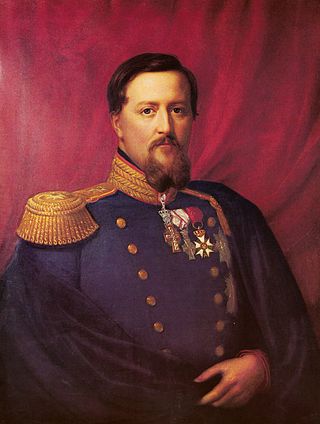
Frederick VII was King of Denmark from 1848 to 1863. He was the last Danish monarch of the older Royal branch of the House of Oldenburg and the last king of Denmark to rule as an absolute monarch. During his reign, he signed a constitution that established a Danish parliament and made the country a constitutional monarchy. Frederick's motto was Folkets Kærlighed, min Styrke.

Frederick V was King of Denmark and Norway and Duke of Schleswig-Holstein from 6 August 1746 until his death in 1766. A member of the House of Oldenburg, he was the son of Christian VI of Denmark and Sophie Magdalene of Brandenburg-Kulmbach.

Amalienborg is the official residence for the Danish royal family and is located in Copenhagen. Frederick VIII's palace complex has four identical Classical façades, effectively four palaces, with Rococo interiors, laid around an octagonal courtyard. At the centre is a large equestrian statue of Frederick V. Amalienborg was originally built for four noble families, but after Christiansborg Palace burned in 1794 the royal family bought the palaces and moved in. Over the years various monarchs and their families have lived there, including today's King Frederik X and Queen Mary.

Christiansborg Palace is a palace and government building on the islet of Slotsholmen in central Copenhagen, Denmark. It is the seat of the Danish Parliament, the Danish Prime Minister's Office, and the Supreme Court of Denmark. Also, several parts of the palace are used by the Danish monarch, including the Royal Reception Rooms, the Palace Chapel and the Royal Stables.
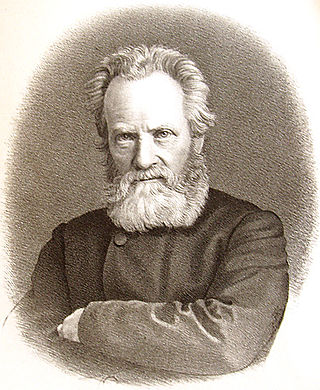
Herman Wilhelm Bissen was a Danish sculptor. Bissen created a number of public works, working in plaster, marble and bronze.

The Church of Our Lady is the Lutheran cathedral of Copenhagen. It is situated on the Frue Plads public square in central Copenhagen, next to the historic main building of the University of Copenhagen.
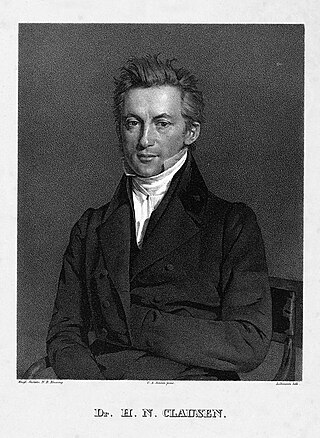
Henrik Nicolai Clausen was a Danish theologian and national liberal politician. He was a member of the National Constitutional Assembly from 1848 to 1849, of the Folketing from 1849 to 1853 and of the Landsting from 1853 to 1863.

The monarchy of Denmark is a constitutional institution and a historic office of the Kingdom of Denmark. The Kingdom includes Denmark proper and the autonomous territories of the Faroe Islands and Greenland. The Kingdom of Denmark was already consolidated in the 8th century, whose rulers are consistently referred to in Frankish sources as "kings". Under the rule of King Gudfred in 804 the Kingdom may have included all the major provinces of medieval Denmark.

Christian Gottlieb Vilhelm Bissen was a Danish sculptor. He was also a professor at the Royal Danish Academy of Fine Arts with great influence on the next generation of Danish sculptors and for a while served as its director. Bissen was trained in the Neoclassical tradition from Bertel Thorvaldsen but after a stay in Paris around 1880, he was influenced by Naturalism. With the equestrian statue of Absalon he turned to Neo-romanticism.

The second Christiansborg Palace was a new main residence for the Danish Monarch built from 1803 to 1828 in Copenhagen as a replacement for the first Christiansborg Palace which had been destroyed by fire in 1794. The new palace was constructed on Slotsholmen, on the ruins of its predecessor, and designed by royal master builder Christian Frederik Hansen. By the time the palace was completed, King Frederick VI had found himself comfortable at his temporary residence at Amalienborg Palace and decided he did not want to live in the new palace after all. He only used the royal premises for entertainment. The palace also housed the Parliament and administrative services. Frederik VII was the only monarch to live in the palace. This was between 1852 and 1863.

Jægerspris Castle, in Jægerspris on the Hornsherred peninsula west of Copenhagen, is a Danish manor house. It has belonged to the Danish monarchs for most of its history which dates back to the 13th century. In the 1850s it became a retreat for King Frederik VII and his morganatic wife Countess Danner, who sought refuge there to escape the controversy their marriage had caused among the establishment in Copenhagen. After the king's death, Countess Danner turned it into an asylum for women.
Events from the year 1873 in Denmark.
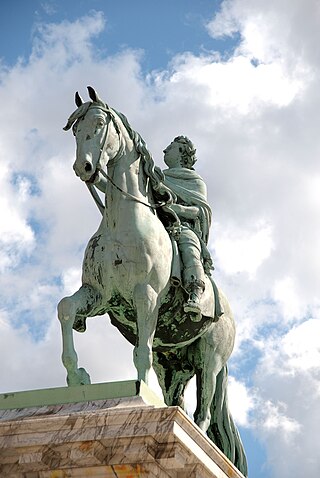
Danish sculpture as a nationally recognized art form can be traced back to 1752 when Jacques Saly was commissioned to execute a statue of King Frederick V of Denmark on horseback. While Bertel Thorvaldsen was undoubtedly the country's most prominent contributor, many other players have produced fine work, especially in the areas of Neoclassicism, Realism, and in Historicism, the latter resulting from growing consciousness of a national identity. More recently, Danish sculpture has been inspired by European trends, especially those from Paris, including Surrealism and Modernism.

Civiletatens Materialgård is a former storage facility at Frederiksholm Canal in Copenhagen, Denmark. The complex was used for the storing of materials used for the royal palaces but also has a long history as home and work place for sculptors associated with the Royal Danish Academy of Fine Arts. Together with the adjacent Fæstningens Materialgård, its military counterpart, and the Royal Horse Guards Barracks, it forms a cluster of low, yellow-washed buildings alongside Frederiksholm Canal. It now houses the Art Academy's School of Sculptury as well as residences.

The Coronation Chair of Denmark is the chair formerly used in the coronation of the Danish monarch.

The coronation of the Danish monarch was a religious ceremony in which the accession of the Danish monarch was marked by a coronation ceremony. It was held in various forms from 1170 to 1840, mostly in Lund Cathedral in Lund, St. Mary's Cathedral in Copenhagen and in the chapel of Frederiksborg Palace in Hillerød.
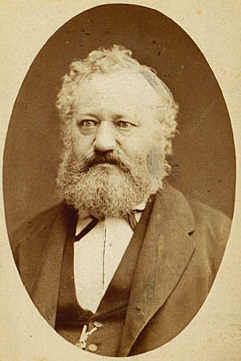
Lauritz Godtfred Rasmussen was a Danish zinc and bronze caster. He established a zinc and bronze foundry in his own name in Copenhagen in 1865 and was appointed royal court caster in 1883. Many Danish monuments from the second half of the 19th century come from his foundry. It was later taken over by his son Carl Rasmussen and remained in the family for several generations.

The equestrian statue of Christian IX, overlooking Christiansborg Ridebane on Slotsholmen in Copenhagen, Denmark, was created by Anne Marie Carl-Nielsen. Unveiled in 1927, it was the first equestrian statue of a monarch created by a woman sculptor.

The statue of Frederick VI greets visitors just inside the main entrance to Frederiksberg Park at Frederiksberg Runddel in the Frederiksberg district of Copenhagen, Denmark. Unveiled on 10 September 1858, the bronze statue was created by Herman Wilhelm Bissen and is considered one of his best works. It is the first public depiction of a Danish monarch in everyday, contemporary attire, rather than that of antiquity, or galla uniform, popular in earlier sculpture.
























